British anti-tank infantry during World War II
For the first time, foot soldiers met a new rival on the battlefield during the First World War. It was then that the first to enter the battlefields Tanks - a dangerous and almost invulnerable to the infantry enemy, who, with his appearance, inspired terror in the soldier. Since the active use of armored vehicles on the battlefields was at the final stage of the First World War, they did not even have time to create special means to combat them. But in the interval between the two world wars, many countries of the world carried out work on the creation of samples of various weapons for fighting tanks. Anti-tank infantry weapons had to be sufficiently mobile and ensure the destruction of armored vehicles at a sufficient distance. One of the first countries in the world where such weapons were created was Great Britain.
In October, 1934, the English military leadership initiated a project to develop an anti-tank gun (PTR). This project was headed by the captain of the British Army Boyce (HC Boys), a well-known weapon expert, assistant to the head of the design bureau of the Royal Small Arms Factory in Enfield. Work on the creation of anti-tank guns were carried out in the framework of the work of the British Committee of light weapons, the code name of the project - Stanchion "(" Backup "). After the ground tests of the British anti-tank system were completed in November, 1937 was officially put into service, having received the designation “Boys Anti-Tank rifle Mark I” (Boyes’s 1 anti-tank rifle). It was originally noted that it was not planned to give the name of one developers, however, shortly before the adoption of the APP into service, Captain Boyes died, which was the reason for perpetuating his name, calling an anti-tank gun in his honor.
Initially, the gun was planned under the 12,7-mm cartridge from a large-caliber machine gun "Vickers". But tests have shown that the impact of a bullet of this caliber on the target is not as significant as expected. As a result, in 1936, a special cartridge was developed for the MTR, which was then given the designation .55 Boys or 13,9х99В. The cartridge had a brass sleeve with a rim and an armor-piercing bullet. At a meeting angle with a target of 90 degrees at a distance of 100 meters, a W Mk.I bullet with a steel core of 60 grams could penetrate 16-17 mm of armor. A W type bullet Mk.II, which had a tungsten core (47,6 bullet weight per gram) at a distance of 100 meters at an angle of 70 degrees, pierced an 20-mm armor plate. These characteristics made it possible to use BoTR Mk I anti-tank guns against any armored personnel carriers and vehicles, as well as light tanks. Especially effective gun was against the field fortifications of the enemy.
From a technical point of view, the Boys Mk I anti-tank gun was a multiply-charged weapon with a rotary cylindrical bolt. The barrel was locked by turning a longitudinally sliding bolt that had 6 protrusions. Recharging PTR was done manually. The gun is powered by ammunition from a single-row box magazine designed for 5 cartridges. The window of the store receiver was located at the top, with the store removed, it was closed with a special lid that flips to the right side of the gun.
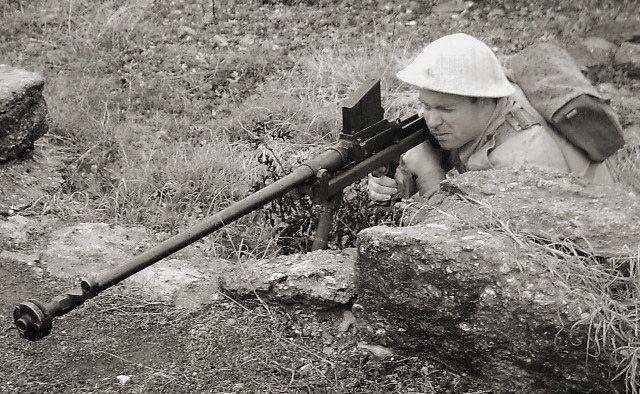
Open sights PTR consisted of dioptric sight and front sight and were carried on brackets to the left of the axis of the bore. Diopter can be set to fire at a range of up to 500 or up to 300 meters. In addition, it was possible to install an optical sight on the weapon. For the convenience of firing from an anti-tank rifle, it had two handles: a pistol pistol, which was located near the trigger, and a rear handle near the butt. The arms of the weapon were a T-shaped support. In the stowed position, the bipods could fold forward. The angle of their inclination in the firing position could be adjusted with the help of clamping screws. The weight of the rifle was 16,3 kg, the PTR Boys Mk I could carry one infantryman on a regular rifle belt behind his back.
In addition to the basic model Boys Mk I, which stood out with a T-shaped bipod and a round massive muzzle brake, in Canada during the war years, production of the modification Boys Mk I * was launched, which was distinguished by a bipedal bipod and a square muzzle brake. Already during the war in 1942, the Boys Mk II model was born, which had a shorter barrel length and was intended to arm the airborne units. In addition to the armament of infantry and airborne units, the Boyes PTRs were mounted on the Standard Beaverette armored vehicle and the Universal Carrier BTR, which was also known as the Bren Gun Carrier.
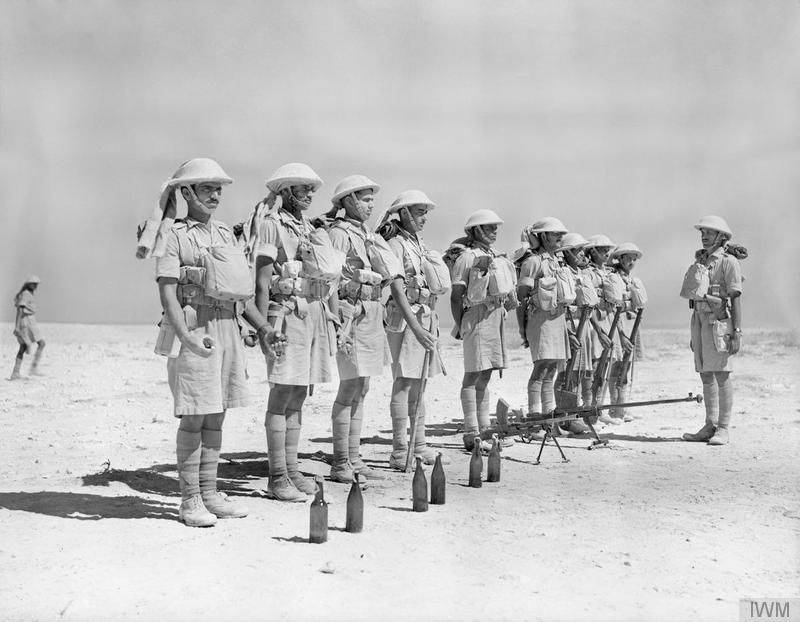
For the first time, these anti-tank rifles in combat were experienced not by the British, but by the Finns - during the Soviet-Finnish war of 1939-1940. Orders for these PTRs from the British Army were received before January 1942, when it became clear that they were becoming ineffective against modern armored vehicles. With the advent of a large number of medium and heavy tanks, distinguished by good armor, the use of Beuys MTR for the intended purpose almost disappeared. Now the anti-tank gun was used only to combat light armored vehicles and fortifications. The PIAT English grenade launcher has replaced the PTR data.
However, after the end of the Second World War, Beuys APPs were still used in various military conflicts. So they were used during the war in Korea, the revolution in the Philippines in 1946-1954, as well as, according to eyewitnesses, during the uprising in the Congo in 1964-1965. The total release of these anti-tank guns exceeded 60 thousands of units.
Technical characteristics of PTR Boys Mk.I:
Caliber - 13,9 mm.
Patron: .55 Boys (13.9x99B)
Mass of weapons without ammunition - 16,3 kg.
Length - 1626 mm.
Barrel length - 910 mm.
Magazine capacity - 5 cartridges.
Armor penetration (distance / meeting angle / penetrability):
with bullet W Mk.1: 100 m / 90 ° / 16 mm.
with bullet W Mk.2: 100 m / 70 ° / 20 mm.
After the defeat of the English expeditionary corps under Dunkirk, the command of the armed forces of Great Britain faced a serious shortage of weapons. In the entire British army, only 167 anti-tank guns remained. The military, along with anti-tank guns, were forced to turn their attention to improvised means to fight the enemy’s armored vehicles. Against the background of the threat of a possible German invasion of the islands, the British army urgently needed a cheap anti-tank weapon. As a result, the construction proposed by Major Harry Northover was recognized. He proposed a grenade launcher, which, according to his calculations, cost no more than 10 pounds. The Northvera grenade launcher was introduced to Winston Churchill himself as a simple and very cheap anti-tank weapon. After the demonstration, Churchill gave the order to immediately begin production of this grenade launcher.
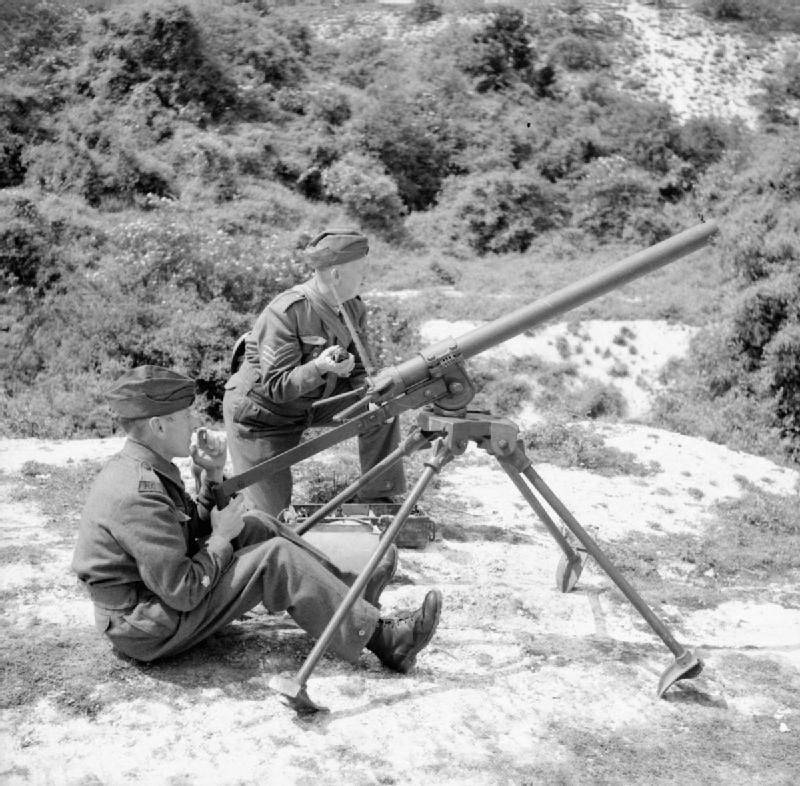
Among the soldiers, this grenade launcher was nicknamed "bottle mortar." It was extremely simple and was a pipe mounted on a tripod, having the simplest slide mechanism in the breech. It was planned to use rifle and hand grenades as well as incendiary bottles (a mixture of gasoline and phosphorus) as ammunition. A small amount of black powder, which was activated by the primer of a toy pistol, was used as a propellant charge. Targeting a grenade launcher at the target carried a long handle, which is adjacent to the breech. An aimed shot could be done only 100 meters. The simplicity of the design made the weapon very cheap - around 10 pounds, that is, about 35 dollars (at that rate). For comparison, the famous Thompson submachine gun cost about 300 dollars.
The machine for this unusual grenade launcher was sliding and consisted of 4 tube supports. Directly the grenade launcher itself was attached to the top of the machine with a pin. In the absence of any recoil devices, he took on all the recoil energy from the shot. The machine was the most massive part of the whole structure - its weight reached 27 kg, which significantly reduced the mobility of the entire system. In the modification of the Northover Projector Mk.1 it was facilitated, but it was released in a very small series.
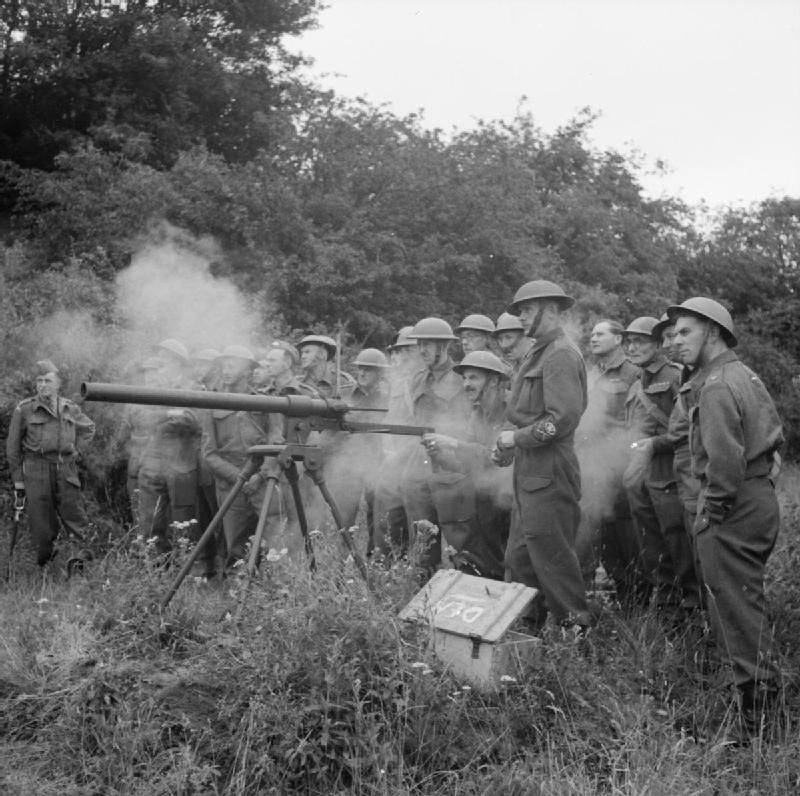
This grenade launcher, literally “made on the knee”, was not popular with the troops. It was inconvenient and unsafe: often glass bottles burst and ignited inside the barrel. In addition, among its shortcomings, the calculation indicated a unmasking white cloud appearing after the shot and the complexity of calculating the charge of gunpowder. But there was nothing better at that time in the UK. By August 1941 had released 8 thousands of such grenade launchers, and by 1943 more than 18 thousands. Basically, they were supplied to the units of the people's militia, where they were presented as an easy-to-learn anti-tank weapon, replaced gradually by more sophisticated models. In real battles, the grenade launcher of Northwehr was never used.
Technical characteristics of Northover Projector:
Caliber - 5 inches
Rate of Fire - 5-8 rds / min.
Weight - 27,2 kg.
Sighting range - 100-120 m.
Calculation - 2-3 person.
The PIAT (Projector Infantry Anti Tank) grenade launcher became a much more advanced anti-tank weapon of the British infantry. This infantry anti-tank grenade launcher was officially put into service in the 1942 year. The weapon was a combination of two anti-tank guns, created a year before by engineers Jeffrey and Wells. Supervised the work on the creation of a grenade launcher Colonel Blanker. The weapon consisted of something between a reactive and a rifle-artillery systems.
The design of the grenade launcher was relatively simple. The PIAT was a tube with a length of 610 mm and a diameter of 76 mm. A tray intended for the installation of a rocket-propelled grenade was welded to its front part, and a T-shaped shoulder rest was fixed on the rear part. In the pipe there was a bolt-drummer for producing the first shot, which had to be manually cocked. The charge, ignited after breaking the capsule, threw the grenade forward and at the same time returned the bolt-drummer to its original position, placing it on a combat platoon. Thanks to this decision, the PIAT could be attributed to a semi-automatic weapon. The expelling charge of the grenade managed to burn before it was completely removed from the tray; for this reason, a stream of hot gases was not formed behind the gun (unmasking shot trail), which allowed infantrymen to fire from shelters. The sighting range of an infantry anti-tank grenade was 100 meters with a maximum range of anti-tank ammunition 250 meters.
During World War II, an 3 type of grenade could be used with a grenade launcher: anti-tank, fragmentation and smoke. The anti-tank grenade provided armor penetration at the level of 120-mm, which in theory allowed the British infantry to fight with almost all German tanks. The grenades used for firing a PIAT rifle consisted of a detonator, a body, an expelling cartridge, and also a tail end with plumage. The grenade launcher also allowed the infantryman to carry out mounted fire with fragmentation grenades at a distance of up to 350 meters, in some situations becoming a substitute for a mortar.
The versatility of the weapon, combined with its simplicity, was the reason why the PIAT anti-tank grenade launcher was used by British and Canadian forces on all fronts of World War II, and was also supplied to the allied armies and resistance forces. After the war, the grenade launcher was used in local conflicts, for example, in the Arab-Israeli war 1948 of the year. In addition, he remained in service with the armies of countries - former British dominions. But he was rather quickly superseded by the more advanced Bazuki. In service with the Israel Defense Forces, this grenade launcher lasted until the middle of the 1950-s, and in the UK it was removed from service in the 1951 year.
Compared with modern anti-tank systems (German Offenror and American Bazooka), the PIAT hand grenade launcher had both positive qualities (no missile exhaust hazard zone, the ability to use a grenade launcher, rooms, a low unmasking action of the shot) strong and painful for fighter recoil when shooting). Total from 1942 to 1950. 115 thousands of these anti-tank grenade launchers were launched.
PIAT specifications:
Grenade caliber - 89 mm.
Weight without grenade - 14,4 kg.
Grenade weight - 1,4 kg.
Overall length - 990 mm.
Rate of Fire - 5-8 rds / min.
Aim range - 100 m.
The maximum firing range - 350 m.
Information sources:
http://weapon.at.ua/load/213-1-0-232
http://weapon.at.ua/load/175-1-0-17
http://world.guns.ru/atr/brit/boys-r.html
http://world.guns.ru/grenade/united-kingdom/piat-r.html
http://warspot.ru/238-s-rogatinoy-na-medvedya
Open source materials
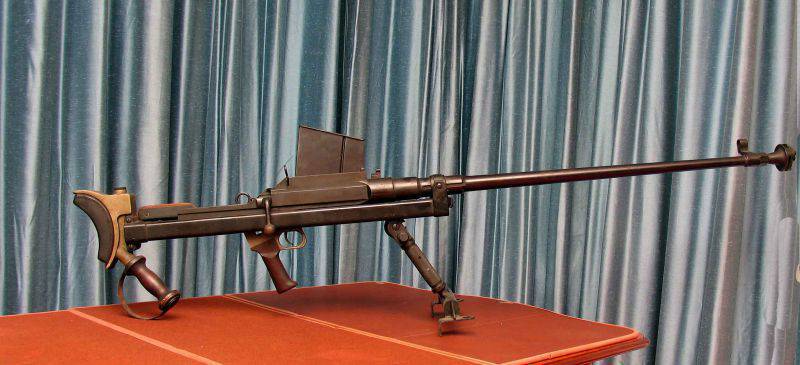
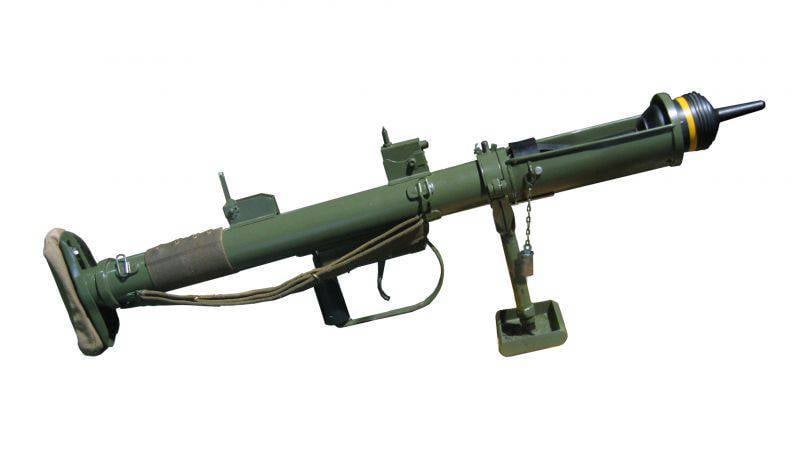
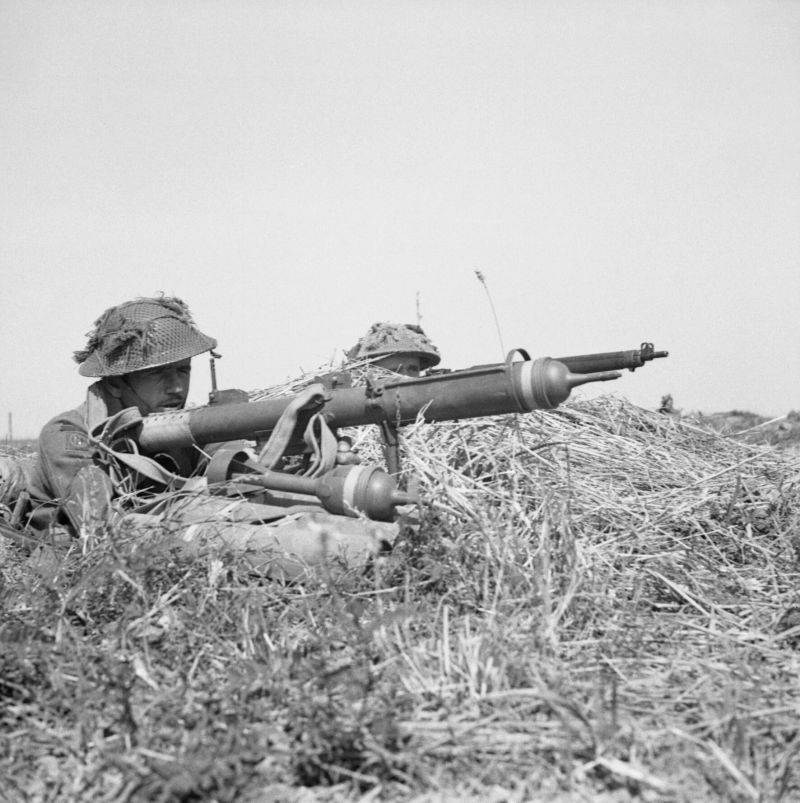
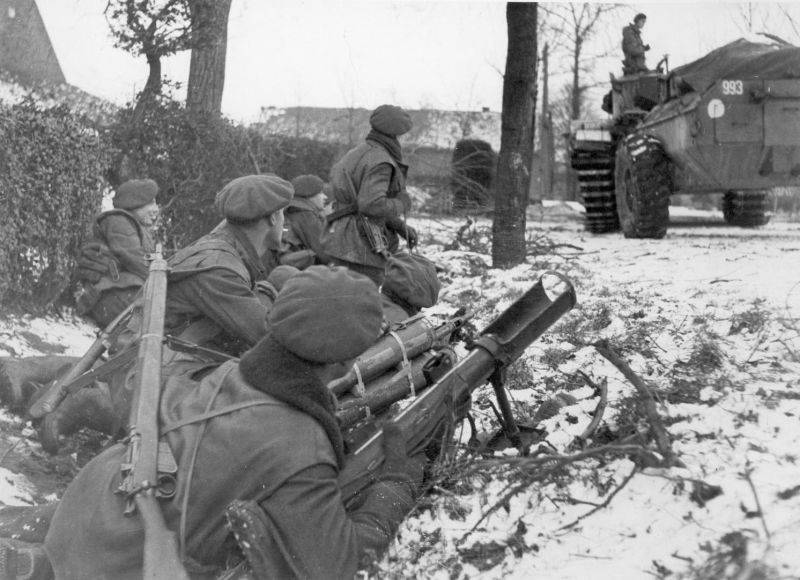
Information